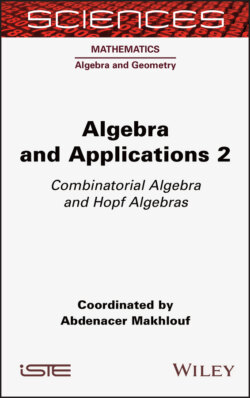Читать книгу Algebra and Applications 2 - Группа авторов - Страница 19
1.3.1. Connected graded bialgebras
ОглавлениеA graded Hopf algebra on k is a graded k-vector space:
endowed with a product m : ℋ ⊗ ℋ → ℋ, a coproduct Δ : ℋ ↑ ℋ ⊗ ℋ, a unit u : k → ℋ , a counit ε : ℋ → k and an antipode S : ℋ → ℋ, fulfilling the usual axioms of a Hopf algebra, and such that:
[1.1]
[1.2]
If we do not ask for the existence of an antipode ℋ, we get the definition of a graded bialgebra. In a graded bialgebra ℋ, we will consider the increasing filtration:
It is an easy exercise (left to the reader) to prove that the unit u and the counit ε are degree zero maps, that is, 1 ∈ ℋ0 and ε(ℋn) = {0} for n ≥ 1. We can also show that the antipode S, when it exists, is also of degree zero, that is, S(ℋn) ⊂ ℋn. It can be proven as follows: let S′ : ℋ → ℋ be defined, so that S’(x) is the nth homogeneous component of S(x) when x is homogeneous of degree n. We can write down the coproduct Δ(x) with Sweedler’s notation:
where x1 and x2 are the homogeneous of degree, say, k and n — k. We then have:
[1.3]
Similarly, m ∘ (Id ⊗ S′) ∘ Δ(x) = ε(x)1. By uniqueness of the antipode, we then get S’ = S.
Suppose that ℋ is connected, that is, ℋ0 is one-dimensional. Then, we have:
PROPOSITION 1.6.– For any x ∈ ℋn, n ≥ 1, we can write:
The map is coassociative on Ker ε and sends ℋn into (ℋn-k)⊗k + 1.
PROOF .– Thanks to connectedness we can clearly write:
with a,b ∈ k and ∈ Ker ε ⊗ Ker ε. The counit property then tells us that, with k ⊗ ℋ and ℋ ⊗ k canonically identified with ℋ:
[1.4]
hence, a = b = 1. We will use the following two variants of Sweedler’s notation:
[1.5]
[1.6]
the second being relevant only for x ⊗ Ker ε. If x is homogeneous of degree n, we can suppose that the components x1, x2, x′, x″ in the expressions above are homogeneous as well, and we then have |x1| + |x2| = n and |x′| + |x″| = n. We easily compute:
and
hence, the coassociativity of comes from the one of Δ. Finally, it is easily seen by induction on k that for any x ∈ ℋn, we can write:
[1.7]
with |x(j)| ≥ 1. The grading imposes:
so the maximum possible for any degree |x(j)| is n — k. □
